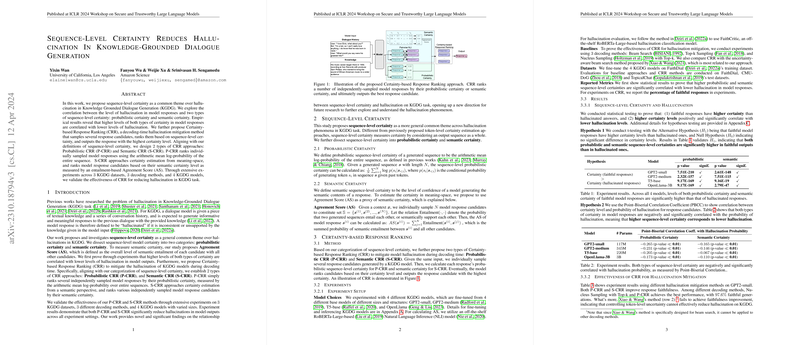Sequence-Level Certainty Reduces Hallucination in Knowledge-Grounded Dialogue Generation
The paper "Sequence-Level Certainty Reduces Hallucination In Knowledge-Grounded Dialogue Generation" offers an insightful investigation into the mitigation of hallucinations within Knowledge Grounded Dialogue Generation (KGDG) systems by exploring the concept of sequence-level certainty. The research delineates two distinct forms of sequence-level certainty: probabilistic and semantic certainty. The paper establishes a correlation between these certainties and hallucination levels in dialogue models. Additionally, the authors introduce Certainty-based Response Ranking (CRR) decoding methods, Probabilistic CRR (P-CRR), and Semantic CRR (S-CRR), which demonstrate efficacy in reducing hallucinations across multiple datasets and models.
Key Findings
- Sequence-Level Certainty and Hallucination: The research demonstrates that increased sequence-level certainty correlates with reduced hallucination in model outputs. Probabilistic certainty is evaluated by measuring the arithmetic mean of log-probability over an entire sequence, whereas semantic certainty relies on an Agreement Score (AS), which assesses semantic entailment among candidate responses.
- CRR Decoding Methods: Two decoding strategies are introduced: P-CRR and S-CRR. P-CRR ranks candidate responses based on probabilistic certainty, effectively prioritizing more likely sequences. S-CRR uses entailment-based semantic analysis to achieve similar goals but focuses on the semantic reliability of generated sequences.
- Empirical Validation: Extensive experimentation across three KGDG datasets and four diverse models (GPT2-small, GPT2-medium, T5-base, and OpenLlama-3B) substantiates the effectiveness of both CRR methods. Results consistently show that outputs generated using CRR approaches demonstrate significantly lower hallucination rates compared to traditional decoding methods.
Implications and Future Directions
The insights from this paper are significant for the development of more reliable and coherent dialogue systems. The proposed models address the issue of hallucination—a critical hurdle in model deployment for practical applications. By integrating sequence-level certainty, future dialogue generation models can better align generated responses with input knowledge, thus enhancing user satisfaction and trust.
Potential future research avenues include exploring the integration of CRR methods with more advanced generative models, such as those leveraging large pre-trained LLMs or multi-modal inputs. Additionally, extending these concepts to other NLG tasks, like abstractive summarization or machine translation, could prove beneficial. Further research could also involve refining CRR approaches to optimize computational efficiency, given the increased resource demands during candidate ranking processes.
Overall, this paper provides a detailed and comprehensive approach to reducing hallucinations in dialogue systems, offering a pathway for researchers to develop more accurate and faithful language generation models.
